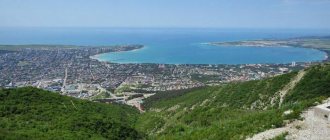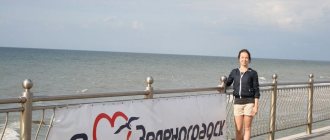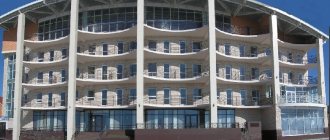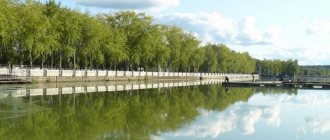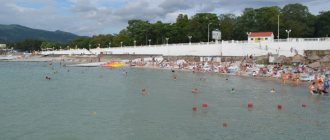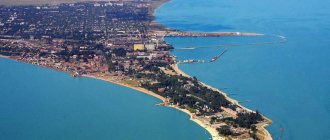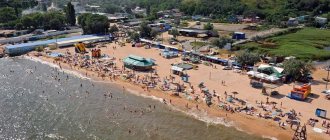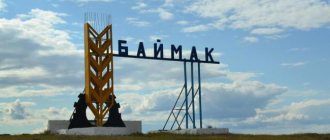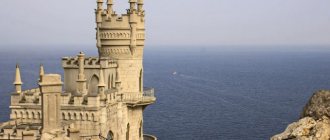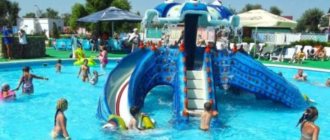Of course, most people have heard the name Gelendzhik at least once. This is a wonderful place that combines a cozy town and a famous resort area, which has gained great popularity and success among tourists. During the holiday season, you can never say that this place is empty. Many people come here every year, most of them not for the first time, they like it so much here. The population of Gelendzhik is very diverse, but they are always hospitable and happy to welcome vacationers to their city. It’s worth talking in more detail about this resort, talking about where it is located, its population, recreational features and attractions of the city.
Gelendzhik - general information
First, you need to consider general information about the city in order to better understand what we are talking about. So, Gelendzhik, as already mentioned, is a wonderful resort town. It is located in Russia, in the Krasnodar region. Its importance for the country is worth mentioning separately - in 2001 it was recognized as a resort of federal significance. It is located on the Black Sea coast.
Of course, in connection with this, all areas of tourism are actively developing here. Its popularity is also increasing every year; holidays in Gelendzhik are already becoming a tradition for many. The local nature fascinates all vacationers, since there is a mountain range nearby and stunning views of the sea.
The population of Gelendzhik, according to data for 2021, is about 72 thousand people. This will be discussed a little later.
Reviews
Judging by reviews from the last three years, the population as a whole is happy with their city. Thus, resort guests share their impressions that Gelendzhik is a calmer city than Sochi, and that it has its own romance. However, they note that in the summer it is a little noisy. Vacationers also write on forums that people here are gentler than in the country as a whole. And the products are quite high quality. They indicate problems with work, the Internet, transport, drinking water and the environment in general. However, there are conflicting opinions regarding the latter. As with the entire Black Sea coast, there is a risk of contracting infectious diseases.
Where is the city?
Now it’s worth talking about the geographical location of this wonderful resort town. The city of Gelendzhik occupies a fairly large territory, its area is about 1925 hectares. The settlement is located near another famous city - Novorossiysk, just 25 kilometers southeast of it. Another landmark is the mountain range with the unusual name Markoth. The city is located right at the foot of this mountain.
Story
The Black Sea coast of the Caucasus has been inhabited since ancient times. Six kilometers southeast of Gelendzhik, on the eastern outskirts of the village of Svetly, a site of an ancient man of the Acheulean era was discovered in 1966. The studied archaeological material made it possible to clarify the age of the ancient man’s site – 200 thousand years. GELENDZHIK OF THE BRONZE AGE
Tribes of the Bronze Age, with whom we are separated by 5,000 years, immortalized themselves with grandiose funeral structures made of stone slabs - dolmens.
This scientific name was given to the monuments from the first days of their discovery (from the end of the 19th century). Dolmens are megalithic tombs, unique monuments of the past, left to us by the peoples of the Caucasus. Their construction began at the turn of the 4th-3rd millennia BC. In the Gelendzhik region, 23 points with 82 dolmens were explored, of which about 50 have survived to this day. The most accessible for visiting are located in the saddle of the ridge between the peaks of the Nexis and Dolmen mountains, in the village of Svetly, southeast of Gelendzhik, there are two dolmens: one tiled (“big Aderbievsky”) and block with a zigzag pattern on the walls (“small Aderbievsky”). GELENDZHIK IN THE ANTIQUE PERIOD
TORIK.
Ancient Greek city of the 6th-5th centuries.
BC. on the shore of Gelendzhik Bay. Mentioned in the work of Skilacus of Cariande “Periplus of the Inhabited Sea” in the 6th century. BC. and in other works of ancient authors. The significance of this settlement, originally a station on the route of Greek ships to the Cimmerian Bosporus, apparently changed over a fairly long period of existence (second quarter of the 6th - mid-5th centuries BC). Torik, founded simultaneously with the first apoikia of the European and Asian Bosporus, existed for more than a century. The population of Torik was engaged in agriculture, fishing, woodworking, metalworking, and making dishes. From here, grain, livestock, leather, and fish of various preparations were exported to the cities of mainland Greece and the colonies. Torik was the easternmost point of the Bosporan state. Torik died in a fire no later than the middle of the 5th century. BC. Perhaps this happened after an attack by barbarian tribes who were hostile to its population. In Roman times it ceased to exist. After the wars of Mithridates Eupator with Rome, at the end of the 1st century. BC e. Political stabilization and economic prosperity of the Bosporus begins, which becomes dependent on Rome. Written sources mention the harbor of Pagra, which replaced the ancient Greek colony of Thorik. Pagras are mentioned by late antique authors of the 2nd century. and V century, their convenient geographical location with excellent anchorages for ships - Gelendzhik Bay and Blue Bay, were apparently one of the military and trade centers in this place of the Black Sea coast in the I century. BC e. – I-II century n. e. PAGRY.
This harbor is mentioned twice: in the 2nd century. and V century. (they no longer existed in the 5th century), most likely this settlement did not exist for long. Earlier written sources about them have not reached us. One can only assume that the name appeared with the arrival of the Romans, under whose power the Bosporan kingdom actually fell, after the death of Mithridates VI Eupator and the collapse of his power, in 63 BC. e.
GELENDZHIK IN THE MEDIEVAL PERIOD
At the end of the XIII-XIV centuries. Genoese colonies began to emerge in Crimea and on the Black Sea coast of the Caucasus. Judging by the data of medieval Italian maps, there were 39 colonies in the territory between Tana (Azov) and Sebastopolis (Sukhumi). Among the names is MAVROLAKO, a Genoese colony (settlement) of the 14th-15th centuries. on the shore of Gelendzhik Bay, the best port of the Circassian coast, very often visited by Italian merchants. The Genoese trade road passed through the territory of Gelendzhik along the route: Feodosia - Anapa - Gelendzhik - the right bank of the Kuban River - the Northern Caspian Sea - Turkestan - Iran - China. The Ottoman Empire put an end to the dominance of the Italians in the Black Sea region by defeating the Genoese colonies. In 1475, the colony of Mavrolaco also ceased to exist.
GELENDZHIK DURING THE CAUCASIAN WAR
As a result of Turkey's defeat in the war of 1828-1829. The Treaty of Adrianople was signed, according to which the entire Trans-Kuban region with the eastern coast of the Black Sea passed to Russia. The Peace of Adrianople marked the end of the nine-year eastern crisis of the 20s of the 19th century. It was concluded by Russia in the difficult conditions of intense rivalry between the great powers in the Balkans and the north-eastern Black Sea coast. In addition, the local tribes, whom Turkey continued to supply with weapons and military supplies, refused to submit to Russia. England took an active part in this, concerned about the growing power of Russia. Attempts by the tsarist government to suppress Turkish and English smuggling operations by organizing cruising of the coast by warships did not bring significant results. Therefore, on the personal instructions of Emperor Nicholas I, the Black Sea coastline was established in 1830. Its fortifications and forts were ordered to be built mainly at the mouths of rivers and in those bays that were used by Turkish ships for smuggling trade. On February 18, 1831, the Emperor approved the location of military fortifications in the Sudzhuk (now Tsemes) and Gelendzhik bays. By July 5 of the same year, the Black Sea Fleet squadron arrived in Sudzhuk Bay, and on July 23, the squadron moved to Gelendzhik Bay consisting of the frigates Tenedos and Erivan, brigs Mercury, Gelendzhik, Pegasus and Castor, the transporter "Sukhum-Kale", the sloop "Diana", and other warships. Until July 27, the bay was inspected and a site was selected for laying the fortification. On July 28, 1831, a landing of ground forces consisting of 4,138 people under the command of Major General Berkhman Ermolai Astafyevich was landed on the Tolsty Cape of Gelendzhik Bay. This date is the foundation of the Gelendzhik military fortification, and subsequently the settlement of Gelendzhik.
GELENDZHIK in the second half of the 19th century
In the early 1860s. there is an expansion of the territory of the Kuban region at the expense of the Trans-Kuban lands, which, on the basis of the rescript dated June 23, 1861 and the “Regulations on the settlement of the foothills of the western part of the Caucasus Range by the Kuban Cossacks and other settlers from Russia” dated May 10, 1862, were provided for use by the Kuban Cossack army for studies in Cossack villages. From April 1 to September 1, 1864, the Russian Cossack population settled the newly occupied spaces on the southern slope of the Main Caucasus Range from Gelendzhik to Tuapse. In May 1864, 800 Cossacks of the Kuban Army and retired sailors of the Black Sea Fleet from the city of Nikolaev were settled in 12 established villages, in the area from Gelendzhik Bay to the Tuapse River. They formed the Shapsug coastal battalion. The name comes from the ethnonym “Shapsugs” - an Adyghe tribe that lived on the Black Sea coast. It included the following villages: Aderbievskaya, Gelendzhikskaya, Pshadskaya, Beregovaya, Vulanskaya, Defanovskaya, Dzhubga (the location of the headquarters). The villages were extremely small in number and were military settlements, with an average of 50 families, and instead of a battalion, only 450 people, divided into three lines, were sent to serve on cordons and longboats. By the end of 1864, there were 629 families (4,157 people) who were displaced. By decree of March 10, 1866, representatives of all classes, as well as foreign subjects of the Christian faith, were allowed to settle in the Black Sea District. The mixed national composition of the population of the steles is a characteristic feature of the Black Sea coast: Russians, Greeks, Armenians, Circassians, Czechs, Moldovans, Estonians, Georgians, and Germans settled here. In 1867, the village of Kabardinka (Greeks) and the village of Armenian (Armenians), formed in 1865-1866, were added to the battalion villages. Christian refugees from the Ottoman Empire. The total number in 1867 was 3,434 people, including 2,915 Cossacks. In 1868, the lands of the Shapsug coastal battalion were annexed to the Black Sea District. In 1870, the villages were transferred to the civil department, and some of the Cossacks returned to the Kuban region. With the transfer of the villages, all coastal settlements were divided into three guardianships (sections): Novorossiysk, Sochinskoye (Dakhovskoye) and Velyaminovskoye (Tuapsinskoye). In 1873, the total number of residents of the 12 villages of the former Shapsug battalion was only 2,760 people of both sexes. After 10 years, almost all the Cossacks moved to the Kuban region. The Russian-Turkish war that began in the late 70s of the 19th century negated what had been achieved, forcing many of the settlers who had taken root on the coast to leave it, abandoning their undertakings and the first results of their work to the mercy of fate. Since the settlement of the coast progressed slowly and the management system was imperfect, by the Decree of March 21, 1888, the Black Sea District was deprived of administrative independence and transferred to the subordination of the head of the Kuban region. This situation remained until 1896. On January 1, 1894, the Novorossiysk section included the settlements - villages: Aderbievka, Beregovaya, Gelendzhik, Kabardinka, Praskoveevka, Pshada, and Velyaminovsky - Arkhipo-Osipovka, Tekos, Teshebs. By the 90s of the 19th century, all the land on the Black Sea coast was sold and given away, and meanwhile the coast continued to be a deserted desert. Of great importance for the development of Gelendzhik was the construction of the Sukhumi highway in 1891, which attracted summer residents; in 1894, the opening of a cement plant of a Franco-Russian company attracted up to 3,000 workers and employees.
FOUNDATION OF THE GELENDZHIK RESORT
In 1900, Doctor of Medicine M.F. Sulzhinsky opened the first private “Black Sea Sanatorium” in Gelendzhik. This date is considered the year the resort was founded. “The wonderful corner occupied by the sanatorium, excellent food and constant medical supervision are without a doubt capable of restoring shattered health...” - this is how one of the patients of the sanatorium responded. Following the Sulzhinsky sanatorium, as the guidebooks of the early twentieth century wrote, “health resorts in Gelendzhik began to grow like mushrooms.” In 1901, Doctor Svetlinsky opened the Blue Sea climatic hospital in False Gelendzhik (now the village of Divnomorskoye). In 1913, the Kuban Medical Society opened a children's bone-tuberculosis sanatorium (DKTS) named after Pirogov on Tonky Cape.
ASSIGNING GELENDZHIK THE STATUS OF AN URBAN SETTLEMENT
Gelendzhik acquired city status on August 5, 1915 in accordance with the Decree of the Sovereign Emperor of the Russian Empire Nicholas II. After the revolution, according to Lenin’s decree “On healing areas,” the committee formed a resort commission, which defines Gelendzhik as a resort of national importance and a healing area for patients with anemia, nervous system disorders, and mild and moderate forms of tuberculosis. On Tonkiy Mys, a DKTS, named after the October Revolution, is reopening. On the basis of nationalized private dachas in 1920-30. In Gelendzhik, Soviet health resorts are being created, including a holiday home for communications workers - the Caucasus boarding house, a sanatorium of the Moscow State University - a sanatorium named after. M.V. Lomonosov. By 1939, the resort consisted of 14 sanatoriums, 16 rest houses, 7 pioneer camps, in which more than 50 thousand people were treated and rested annually. Gelendzhik continues to develop as a climatic resort.
GELENDZHIK DURING THE GREAT PATRIOTIC WAR
Three days after the start of the Great Patriotic War, on June 25, 1941, Gelendzhik, as a port and border city, was declared in a threatened position. From September 1942 to September 1943 The front line ran along the eastern outskirts of the city of Novorossiysk, 30 km from our city. From this period, the purpose of Gelendzhik changed radically. The goals of using the front-line territory became military-strategic, and the tasks of the remaining local population became multifaceted. The city became a working place, a hospital, and a base for combat and material support for the Novorossiysk group of Soviet troops. Combat control over the actions of military forces was carried out from Gelendzhik. Throughout the battle for Novorossiysk, Gelendzhik was subjected to severe enemy bombing. The bombing was especially intense in the areas of the seaport and Tonky Cape - the locations of the Naval Base and aviation. In January-February 1943, in Gelendzhik, a special-purpose detachment was formed under the command of Hero of the Soviet Union, Major Caesar Lvovich Kunikov, to land troops on the southwestern outskirts of Novorossiysk. As a result of fierce fighting, the bridgehead on which the Kunikovites landed was expanded to almost 30 square kilometers and became known as Malaya Zemlya. The military epic on Malaya Zemlya lasted 225 days. All this time, ammunition and manpower were delivered there from Gelendzhik by sea at night, and from there the wounded defenders of the heroic bridgehead were taken out. An operation to liberate Novorossiysk was prepared in Gelendzhik, as a result of which on September 16, 1943 the city was completely liberated from the Nazi invaders. From 1941 to 1945, over 2,000 residents of Gelendzhik died for the freedom and independence of their Fatherland.
POST-WAR SOVIET PERIOD OF GELENDZHIK DEVELOPMENT
After the Great Patriotic War, all residents of Gelendzhik took up the task of restoring the war-ravaged city and sanatorium-resort facilities. In the post-war period, sanatoriums were reconstructed, the medical facilities were improved, and throughput increased. In the 50-60s of the last century, many sanatoriums were expanded, new dormitories were built, medical rooms were replenished with the latest equipment, the capacity of health resorts increased, and the construction of new health resorts began. In 1952, in Gelendzhik and resort villages there were 27 sanatoriums and holiday homes with 5,220 beds. In addition, the number of vacationers without vouchers has reached 40 thousand people per season. Tuberculosis, neurosomatic patients, etc. were treated in sanatoriums. In 1960, by decision of the Government of the RSFSR, sanatoriums and rest homes were transferred to the management of trade unions. In 1963, mainly in the summer season, about 400 thousand workers visited the resort. The total number of health resorts has reached 101, including 10 sanatoriums, a resort clinic with a boarding house, 16 holiday homes, three tourist centers, two car boarding houses, two camping grounds. The bulk of health resorts were represented by small summer recreation centers. On August 28, 1970, by resolution of the Council of Ministers of the USSR No. 723, the Gelendzhik resort received the status of a resort of All-Union significance. In the period 1970-1980, new modern sanatorium and resort facilities were built in Gelendzhik: a 9-story building of the sanatorium named after. Lomonosov, the main and residential buildings of the boarding house "Chernomorets" with a swimming pool (now the "Dolphinarium"), 6-storey buildings of the boarding house "Pine Grove", the main building and dining room of the boarding house "Caucasus", boarding house "Polar Star", new buildings of the boarding house "Primorye" ", new sanatorium "Krasnaya Talka", boarding house "Blue Wave", tourist hotels "Solnechnaya" and "Horizon", boarding house "Thin Cape", sanatoriums "Blue Bay" and Children's bone tuberculosis, boarding houses "Golubaya Dal" and "Energetik" in the village of Divnomorskoye, the boarding houses “Prometheus” and “Nadezhda” in Kabardinka, new buildings and the dining room of the sanatorium “Arkhipo-Osipovka” and others. Pioneer camps were rapidly built: “Znamya”, “Sputnik”, “Brave and Bold”, “Signal”, “Sputnik” in Kabardinka, “Rostselmash”, “Sanatorium-Forest School “Vorkutaugol” in Gelendzhik, “Malozemelets” in Dzhanhot and other. Almost all existing facilities of the sanatorium-resort complex were built during the Soviet period of its development. They are still the flagships of the resort city of Gelendzhik. Also, the bulk of the construction of leading social facilities in the resort city was also carried out in the period from 1970 to 1991. During this time, a medical building of the city hospital, a maternity hospital, a city clinic were built, secondary schools No. 5 and No. 12, kindergartens “Kalinka”, “Aist”, “Lukomorye”, the cinema “Burevestnik”, the Palace of Culture were built according to standard designs resort. The first nine-story residential buildings were built in the mid-70s, and until 1991 such residential microdistricts as Parus, Severny, and Yuzhny were built. Almost the entire social base of the resort was created during this historical period of development of our state. The 1990s became a serious test for the resort, but, despite the difficulties of the perestroika period, many health resorts in Gelendzhik managed to adapt to the conditions of the market economy and maintain a unique medical base.
GELENDZHIK IN THE XXI CENTURY
At the beginning of the 21st century, Gelendzhik retained its status as a seaside climatic resort.
Millions of tourists from our country, near and far abroad come to relax in the resort city, which is unique and especially colorful.
The resort has more than 100 medical and health institutions: sanatoriums, boarding houses, recreation centers, comfortable health resort complexes and children's health camps. The main profile is the treatment of diseases of the upper respiratory tract, cardiovascular system, and musculoskeletal system.
In 2009, Gelendzhik was recognized as the most comfortable city in Russia and was awarded a diploma from the Government of the Russian Federation.
The resort city of Gelendzhik 4 times became the “Best Resort on the Black Sea Coast” in the regional competition of tourism industry leaders of the Krasnodar Territory “Resort Olympus”. This significant award is recognition that the priority in the development of the resort is to create comfortable conditions for life and recreation for citizens of our country, near and far abroad.
In 2021, the municipality of the resort city of Gelendzhik was visited by 3 million 907 thousand 028 people.
Gelendzhik is a favorite vacation spot for people of different ages. The recreation and entertainment industry in Gelendzhik does not stand still, it is developing from year to year: new excursion routes and display facilities are opening (cultural, educational, ethnic, sports and entertainment complexes).
Population of Gelendzhik - detailed information
So, the territory of the city and its location have been considered, and now it’s worth talking about such an important component as the population. As already noted, the number of residents of the city itself is about 72 thousand people. If we talk about the entire urban district, which is called the resort city of Gelendzhik, then its population has a much larger number of people - about 112 thousand people.
Interestingly, in recent years, since 2005, there has been a small but constant increase in population. However, there is no natural growth here; the number of people here increases only due to the attraction of seasonal work in the tourism industry, it is because of this that a significant number of people migrate here.
Flood victim
The contrast of air masses and the large amount of moisture evaporating from the surface of the Black Sea create a serious risk of heavy rains leading to floods. In a warming climate, this threat will only increase. The worst flood occurred here in July 2012, when a small but unusually powerful cyclone caused heavy rains, during which about 300 mm of precipitation fell in one day! Gelendzhik was among the three most flooded cities. The flood claimed the lives of many people, and the number of victims was in the tens of thousands. However, the frequency of floods in Gelendzhik is much lower than in Tuapse, where they are now observed several times a year.
Employment
Of course, most of the people living in the city are employed in the resort and tourism business. Another well-developed area in the city, where a significant number of people work, is the sphere of public catering and trade, which is also explained by the great popularity of this resort place among vacationers.
However, the city has other developed industries besides those directly related to tourism. Mainly, construction and scientific fields can be distinguished among them. The city also has a food industry. Winemaking is especially popular here.
Features of relaxation in this place
So, the basic facts about the territory, geographical location and population of the city were considered. Now it’s worth talking about some of the nuances associated with staying here. When going to the resorts of Gelendzhik, you need to know some of the features of a seaside holiday in these places. Firstly, it must be noted that local nature is not only beautiful and unusual, it has a positive effect on health. Here are magnificent groves of centuries-old pines; they saturate the air with useful substances and make it much cleaner, which undoubtedly has a beneficial effect on the body.
Another important point is that there are practically no operating industrial enterprises in the city, which also contributes to good air quality.
As for the sea, it is calm and quite clean in these places, compared to other areas, due to the fact that the resort is located in a bay. Therefore, tourists with children often choose a holiday in Gelendzhik; here you don’t have to worry about the safety of little vacationers.
Department of Housing and Utilities
Housing and communal services problems in resort areas are a common occurrence. Due to the influx of tourists, there is a shortage of electricity, water, and gas. Tariffs for housing and communal services are very high in Gelendzhik, which are higher than in Moscow. There are problems with the quality of the Internet. In the private sector, all this can be eliminated by installing additional equipment. Therefore, when moving to this city, the best option would be a private house with a plot. The worst situation is in new buildings, where due to a lack of residents, housing and communal services can be turned off in the entire apartment building.
Sea near Gelendzhik
To begin with, it is worth noting that the holiday season in these places lasts quite a long time. Tours to Gelendzhik are most popular between June and September. There is less chance of rainy days at this time. The swimming season here opens in May and lasts about six months. It usually ends in October.
The coastline in this area is flat and has more than 100 different beaches. Interestingly, the total length of the beaches is about 20 thousand meters. In the very center of the bay there is a large beach, which was created artificially. Its length is about a kilometer, and it also has a vast area of more than 5 hectares. Thus, the resort area is well developed to accommodate a large number of vacationers.
The transport network here is well developed; you can easily get to all areas of Gelendzhik. Basically, various buses run here.
Under Ottoman influence
At the end of the 15th century, the lands of the Genoese were captured by the army of the Ottoman ruler. The trading settlement that arose on the site of Mavrolako was named Gelendzhik. For a long time it was a slave market, from where the Turks took young girls to eastern harems. Other goods included timber, livestock, agricultural products and slaves, who were sent to the Trebizond mines. Turkish merchants dictated their terms here for 3 centuries.
There are two versions of the origin of the city's name:
- translated from the Turkic language - “young bride”, according to the type of activity of the settlement;
- translated from the Adyghe name - “small pasture”.
Turkish rulers persistently introduced the Islamic religion to the peoples of the Caucasus. Those who accepted the new religion were exempt from taxes and paid only one fee for the use of land. Disobedience was severely punished. If the khanate was headed by a new ruler, the highlanders had to provide people to form a new army and 300 slaves.
| date | Event |
| 1831 | Foundation of the Gelendzhik fortification as part of the Black Sea fortified coastline |
| 1854 | The territory was occupied until the end of the war by the troops of the Ottoman Empire who arrived from the south. |
| 1857 | Russian troops entered the authorized fortress |
| 1864 | Founding of the village of Gelendzhik as part of the Shapsug coastal battalion |
| 1870 | The village was transformed into the village of Gelendzhikskoye as part of the Novorossiysk department of the Black Sea District |
| 1896 | Village of Gelendzhik |
| 1900 | Opening of the first private sanatorium |
| 1907 | The coast of Gelendzhik Bay has officially become a resort |
| 1915 | Gelendzhik received city status |
| 1923-1963 | Gelendzhik - the center of the Gelendzhik region |
| 1970 | Gelendzhik is a resort of all-Union significance |
Health resorts of Gelendzhik
Probably, many have heard that vacationing in these places not only gives you positive impressions, but, in some cases, is very good for your health. Indeed, there are special tours to Gelendzhik that are aimed specifically at treating or healing the body. The peculiarity of the resort is that there are a large number of mineral water springs nearby. There are both their deposits and self-flowing springs here. Their total number in the Gelendzhik region is more than 20. In addition to healing waters, special medicinal mud is used here to treat various diseases.
There are many sanatoriums and other health institutions in the city, where various diseases of the cardiovascular system, nervous system, respiratory system, endocrine system, etc. are treated.
The city's attractions
As you know, the city of Gelendzhik has a rich history. It is not surprising that over the long period of the city’s existence, many cultural monuments have appeared here. When going on a trip to this resort, many people want to see the sights in order to become better acquainted with the history and culture of the city.
To begin with, it is best to explore the center of Gelendzhik; here you can walk along the pleasant and quiet streets and feel the atmosphere of this sunny city.
There are also several interesting museums located here. The first is a local history museum. It is definitely worth a visit, because in the museum you can learn a lot of interesting things about the history of these lands. The second object is the House-Museum of the writer Vladimir Korolenko. Here you can get acquainted with his life and work.
In Gelendzhik there are many monuments dedicated to famous people and various important events, for example, a monument dedicated to the bicentenary of A. S. Pushkin, a monument to M. Yu. Lermontov (nearby there is a boulevard dedicated to the poet), a monument to V. I. Lenin and others. You can often see city residents and tourists near the monument to the heroes of the Great Patriotic War.
It will also be interesting to see the local architecture; it is represented by various churches, for example, the Church of the Ascension of the Lord, the Holy Transfiguration Church and others are located here.
How to get to the resort?
So, information about Gelendzhik, the features of recreation in these places, local attractions and much more were examined in detail. Now it’s worth talking about how you can get to the resort. There are several options for traveling to Gelendzhik, you can always choose the most suitable one.
The first and most common way to get to the city is by rail. The train does not go to Gelendzhik, but in this case it is convenient to get to Novorossiysk by it. From there, from the railway station, you can get to Gelendzhik by bus or taxi, which won’t take much time. Travel time by train from Moscow to Novorossiysk is approximately 1.5 days. Most people who want to travel to Gelendzhik in June usually buy tickets well in advance of the trip as it is the most popular month.
The second travel option is to go by personal vehicle. This method is also very convenient, since in this case it becomes possible to independently move around the city and its environs, as well as explore various sights. To get there from Moscow, you need to follow the M4 Don highway. The distance between the two cities is about 1518 kilometers. The trip will take about 18 hours.
Transport
The city is located on the M4 Don federal highway, well known to many Russians. It goes around the city in the northeast, so as not to create problems for vacationers. The congestion on the route is high. Another type of external transport is sea and air. There are no railways, which distinguishes Gelendzhik from other resorts on the Black Sea coast of Russia.
Intracity and suburban transport is represented by buses. There are also several taxi organizations. The city has two cable cars that take tourists to the mountainous surroundings of Gelendzhik.
Is it possible to get to Gelendzhik by plane?
In addition to the listed ways to get to this popular resort, there is another option. You can fly to the city by plane. There are flights from Moscow, St. Petersburg and other major Russian cities. There is an airport in Gelendzhik, but some tourists prefer to fly to Anapa, followed by travel to Gelendzhik. Flights from Moscow usually depart every day. Flight time is 2 hours 20 minutes. This method will be convenient for those who have a short time allocated for vacation, which would be a shame to waste on the road to the resort.
Shopping and souvenirs
In addition to the standard set of souvenirs in the form of a magnet and a T-shirt with the name of the resort, you can bring from Gelendzhik beautiful shells and various crafts made from them - jewelry, interior items, dishes, etc. In addition, crafts made from natural materials such as clay, bamboo, stone are also common here .
And, of course, the gastronomic souvenirs presented here in the form of nuts, honey and tea are worthy of special attention. These products are distinguished by high quality and a unique taste, evoking thoughts of past southern holidays.
Interesting facts about Gelendzhik
Since Gelendzhik is a popular place and attracts the attention of a large number of people, it is surrounded by various stories and facts that would be interesting to know.
Firstly, it is worth noting that this region occupies an important place in the work of some writers and poets. The most famous among them is M. Yu. Lermontov. According to some sources, the writer was here in 1837 on military duty. It was here that he was inspired to write his famous novel, A Hero of Our Time. In this work, the main character, Pechorin, takes exactly the same route as Lermontov. In the city, as already mentioned, there is even a monument dedicated to the writer, on the pedestal of which there is a facsimile of his seal. Nearby there is also a boulevard named after Lermontov.
Another interesting thing worth paying attention to is the hydroair show, which is periodically held in the city. This event is an exhibition of aviation achievements related to water and ship-based operations. It is carried out once every 2 years.
